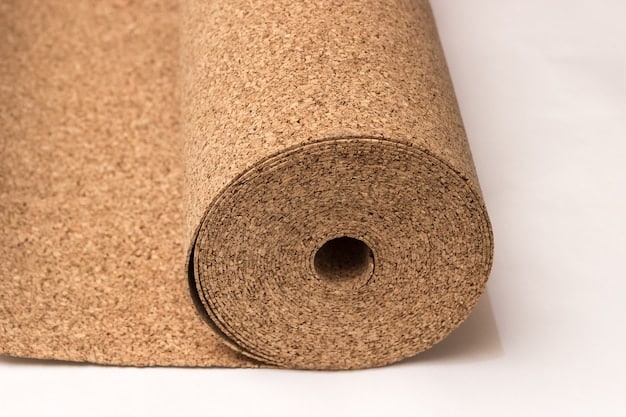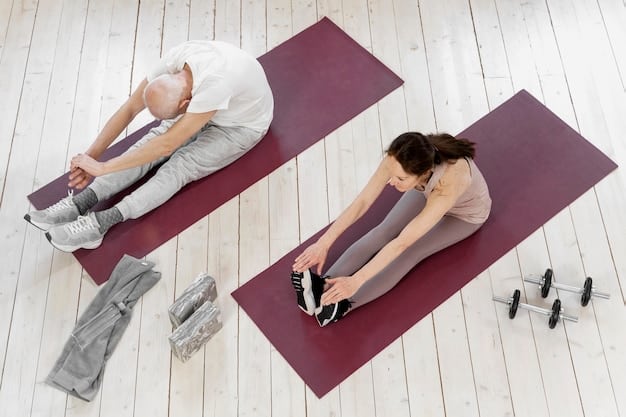The Ultimate Guide to Yoga Mat Selection: Practice and Budget

Choosing the right yoga mat involves considering material, thickness, texture, and price to enhance comfort, support, and grip, ultimately improving your yoga practice.
Embarking on or deepening your yoga journey? The foundation of a fulfilling practice often lies in the right equipment, and the yoga mat is paramount. This ultimate guide to choosing the right yoga mat for your practice and budget will navigate you through the sea of options to find the perfect fit.
Understanding Yoga Mat Basics
Before diving into the specifics, let’s establish a baseline understanding of what makes up a yoga mat. Knowing the components and their impact will empower you to make informed decisions.
Material Matters
The material of your yoga mat significantly impacts its grip, durability, eco-friendliness, and overall feel.
- PVC (Polyvinyl Chloride): Known for its stickiness and affordability, PVC mats are a popular choice, especially for beginners. However, they are not biodegradable and can contain phthalates, which are harmful chemicals.
- TPE (Thermoplastic Elastomer): A blend of plastic and rubber, TPE mats are more eco-friendly than PVC and offer a good balance of cushion and grip. They are also lightweight and recyclable.
- Natural Rubber: Derived from rubber trees, these mats are eco-friendly and offer excellent grip. They can be heavier and may have a distinct rubber smell, which dissipates over time.
- Cork: A sustainable and naturally antimicrobial option, cork mats provide a firm, comfortable surface with excellent grip, especially when damp.
- Jute: Often combined with rubber, jute mats offer a natural texture and good grip. They are eco-friendly and durable.
Choosing the right material is crucial for comfort and environmental considerations.

Thickness and Cushioning
The thickness of your yoga mat affects your comfort, especially during poses that put pressure on your joints. Your choice should align with your tolerance and the intensity of your practice.
Standard Thickness
Most yoga mats are around 3-5mm thick, offering a good balance of cushioning and stability.
Thicker Mats
Thicker mats (6mm or more) provide extra cushioning for sensitive joints, which is beneficial for those with knee or back issues, but can impact your balance in standing poses.
Travel Mats
Thinner mats (1-2mm) are lightweight and easy to travel with, but offer minimal cushioning.
Ultimately, thickness is a personal choice depending on your comfort level and preferred style of yoga. Consider how the mat supports your body during practice.
Texture and Grip: Staying Grounded
A mat’s texture plays a significant role in preventing slips and slides, ensuring you maintain stability and focus during your practice.
Surface Texture
Look for mats with a textured surface to enhance grip. This is crucial for preventing injuries and maintaining proper alignment.
- Raised Patterns: Provide tactile grip and prevent slipping.
- Smooth Surfaces: Can be slippery, especially when wet, and are better suited for less intense practices.
- Combination Textures: Offer a balance of grip and comfort.
The texture you choose should complement your practice’s intensity, providing the necessary grip and stability for complex poses.
Yoga Styles and Mat Suitability
Different styles of yoga demand different mat characteristics. A mat that excels in one style may fall short in another.
For Hot Yoga
Styles like Bikram or Hot Yoga require mats with superior grip and moisture-wicking properties.
For Hatha or Restorative Yoga
Hatha and Restorative Yoga benefit from thicker, more cushioned mats for comfort and support.
For Vinyasa or Ashtanga
Vinyasa and Ashtanga require a balance of grip and support to transition between poses smoothly.

Budget Considerations
Yoga mats range widely in price, reflecting differences in material, brand, and features. Understanding your budget will help you narrow down your options.
Entry-Level Mats
Affordable PVC mats are a great starting point for beginners.
Mid-Range Options
TPE and rubber mats offer a good balance of quality and price.
Premium Mats
Cork and high-end rubber mats are an investment in durability and performance.
Remember to consider the longevity of the mat. While a cheaper mat may save money initially, a more durable option could be more cost-effective over time.
Maintenance and Care for Longevity
Proper maintenance extends the lifespan of your yoga mat. Simple steps can keep it clean, hygienic, and performing optimally.
Cleaning Routines
Regularly wipe down your mat with a mild soap and water solution or a specialized yoga mat cleaner.
Storage Tips
Store your mat rolled up in a cool, dry place away from direct sunlight to prevent damage.
Avoiding Damage
Avoid using harsh chemicals or abrasive cleaners, which can degrade the material.
Incorporating these maintenance practices into your routine will help maintain hygiene and extend the life of your mat, ensuring it remains a reliable part of your yoga practice.
| Key Aspect | Brief Description |
|---|---|
| 🌿 Material Choice | Different materials (PVC, TPE, Rubber) affect grip, eco-friendliness, and durability. |
| 📏 Thickness | Ranges from thin (travel) to thick (cushioned), impacting comfort and stability. |
| 🧘♀️ Yoga Style | Hot yoga needs grip; restorative needs cushion; Vinyasa needs balance. |
| 💰 Budget | Entry-level PVC to premium cork influence longevity and initial cost. |
Frequently Asked Questions
▼
PVC mats are often recommended for beginners due to their affordability and good grip. They provide a solid foundation for starting your yoga journey.
▼
A standard thickness of 3-5mm is suitable for most practices, offering a balance of cushion and stability. Adjust based on personal comfort.
▼
It’s best to use a mat designed for hot yoga, which offers superior grip even when wet. Look for moisture-wicking properties for added comfort.
▼
Wipe down your mat after each practice to remove sweat and dirt. A deeper clean once a week will keep it fresh and hygienic.
▼
Yes, eco-friendly mats like those made of natural rubber or cork are sustainable and often offer superior grip and durability, making them a worthwhile long-term investment.
Conclusion
Choosing the right yoga mat is a personal journey that depends on your individual needs, preferences, and budget. By considering factors like material, thickness, texture, and intended style of yoga, you can confidently select a mat that enhances your practice and supports your well-being.





